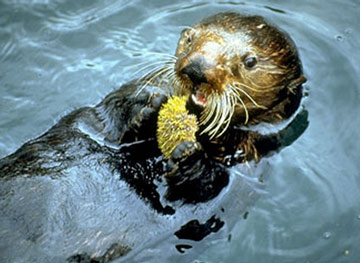Floating along on its back, using its tummy as a table as it snacks on a clam or scallop, the sea otter is downright adorable.
 A sea otter feeding on a sea urchin. Credit: National Oceanic & Atmospheric Administration
A sea otter feeding on a sea urchin. Credit: National Oceanic & Atmospheric AdministrationBut all that cuteness masks the fact that the otter is also a hard worker. To survive the frigid waters of the north Pacific, it has to eat about a quarter of its body weight every day, which keeps it busy. And its appetite can help keep coastal ecosystems strong and healthy.
Otters eat so much because it’s the way they maintain their body temperature. Unlike other marine mammals, they don’t have a layer of fat to insulate them. Instead, they have two dense layers of fur. The outer layer provides protection, while the inner layer traps air. The otter’s body heat warms that insulating layer of air.
The otter’s fur is the densest of any mammal, which in the 18th and 19th centuries made their pelts prized catches for hunters. In fact, otters were hunted to near extinction -- only a few thousand remained. But conservation measures have helped the population rebound to a hundred thousand or more.
And that appears to be good news for coastal habitats. One of an otter’s favorite foods is the sea urchin. The otter dives to the bottom and roots around until it finds a supply of urchins or other food. Back at the surface, it uses rocks to break open shells and get at the good parts.
Sea urchins can decimate kelp beds, which provide habitat for fish and other creatures. But otters keep the urchins in check. So otters are not only darned cute, they’re darned useful, too.

